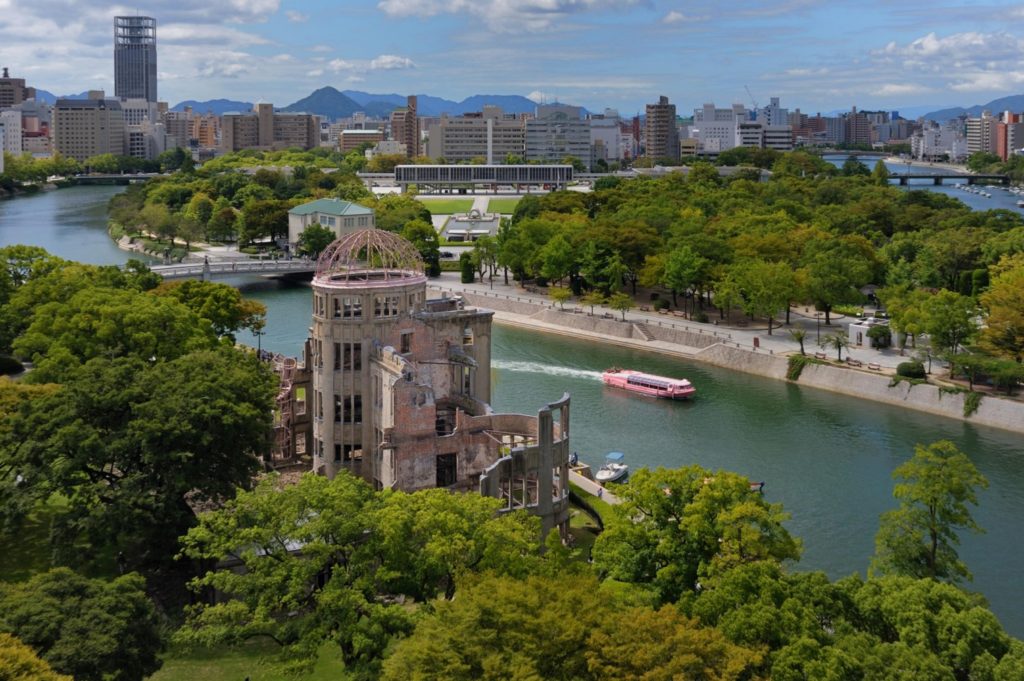Perspectives from Hiroshima ~A reflection on nuclear weapons and SDG implementation~
The following is a summary of the presentation made by Governor Yuzaki of Hiroshima Prefecture at a special session of the United Nations High Level Political Forum held in New York on July 5, 2022.
(Govenor Yuzaki)
Hello everyone. I am Hidehiko YUZAKI, Governor of Hiroshima Prefecture and President of Hiroshima Organization for Global Peace, or HOPe for short.
Allow me to begin by expressing my deep appreciation to everyone at the Division for Sustainable Development Goals (DSDG) in the United Nations Department of Economic and Social Affairs (DESA), and the United Nations Institute for Training and Research (UNITAR) for providing the Hiroshima Prefectural Government and HOPe with the opportunity to organize one of the Special Sessions of the United Nations High-Level Political Forum 2022, which is attracting much attention worldwide. Hiroshima Prefecture and HOPe are honored to be able to assume this role for the second consecutive year.
In considering nuclear weapons and sustainability, I would like to begin by examining the Ukrainian crisis, which we are now witnessing. First and foremost, I sincerely hope that the Ukrainian people can return to a peaceful, normal way of life as soon as possible. Looking at the relationship between the Ukrainian crisis and the Sustainable Development Goals (SDGs), the crisis has very seriously affected initiatives for all the SGDs, not only in Ukraine but also the rest of the world. For example, the recent decline in wheat exports from Russia and Ukraine, which together account for nearly 30% of global wheat supplies, has exacerbated the food crisis. Such negative impacts on the achievement of the SDGs are becoming obvious on a global basis.
Moreover, in the wake of the Ukrainian crisis, the world has been faced with nuclear dangers, due to Russia’s threat to deploy nuclear weapons and the Russian military’s attack on a nuclear power plant in Ukraine. Fortunately, nuclear weapons so far have still remained unused. It was 76 years ago that these weapons were last used in actual warfare in Hiroshima and Nagasaki.
This photograph shows Hiroshima City shortly after the atomic bomb was dropped.

As you look at the photograph you can perceive intuitively that the use of nuclear weapons would inflict devastating damage on the achievement of every SDG. In fact, 76 years ago Hiroshima sustained catastrophic damage in various aspects, such as industrial and living infrastructure, educational institutions, and healthcare services, with its soil, forests, and ocean seriously contaminated. Before anything else, many precious lives were lost, including women, children, and the elderly. At the present moment, when we are faced with the Ukrainian crisis, we should remind ourselves again that nuclear weapons constitute an unequivocal threat to the sustainable future of humanity.
There are some people who argue that the possession of nuclear weapons is acceptable as long as they are not used. However, even if not used, nuclear weapons continue to have significant negative impacts on the achievement of the SDGs. Just the production and possession of these weapons have brought about various problems, for example, health damage to uranium miners during the production process, human suffering as well as ocean and forest contamination resulting from nuclear tests, and environmental pollution caused by nuclear waste, to name but a few.
In addition, even if there is no intention to use nuclear weapons, their existence may lead to the occurrence of accidents. Such a risk will never be completely eliminated so long as nuclear weapons are possessed. By 2045, the “singularity” is predicted to occur, which means the moment at which artificial intelligence surpasses human intelligence. Then it is highly likely that the management of nuclear weapons will be beyond human control. We must review the issue of nuclear weapons from the perspective of the sustainability of humanity and the planet, and recognize anew that both nuclear-weapon states and non-nuclear-weapon states are all on the same Spaceship Earth.
Here is a photograph of present-day Hiroshima City.

With the help of the international community, Hiroshima made a remarkable recovery from the devastation wrought by the atomic bomb. It was possible because post-war Japan was able to demonstrate the resilience of its society by focusing the country’s efforts on economic and social reconstruction in place of military affairs, which had been emphasized until then. Hiroshima as it is known today provides an important suggestion to the international community, which aims at building back better from the coronavirus (COVID-19) pandemic. The international community is required to ensure that the resources that are now allocated to military affairs and nuclear weapons will be redirected to initiatives for building back better after COVID-19.
Hiroshima succeeded in reviving itself from the ashes. However, the precious human lives lost in the nuclear calamity and genetic damage from exposure to radiation could never be restored. Due to this tragedy, infinite number of traditional assets cannot be passed on the later generations. It is important to prevent risks before they turn into a catastrophe. The case of the climate change issue, there are two ways to deal with, “mitigation” and “adaptation,” but there can be no adaptation to the nuclear weapons problem, mitigation is difficult, and once if nuclear weapons are used, that’s it. In that sense, the issue of nuclear weapons is more serious than climate change, and prevention is the only solution. Now it is our challenge to realize prevention by collecting the wisdom of humanity.
Related article




